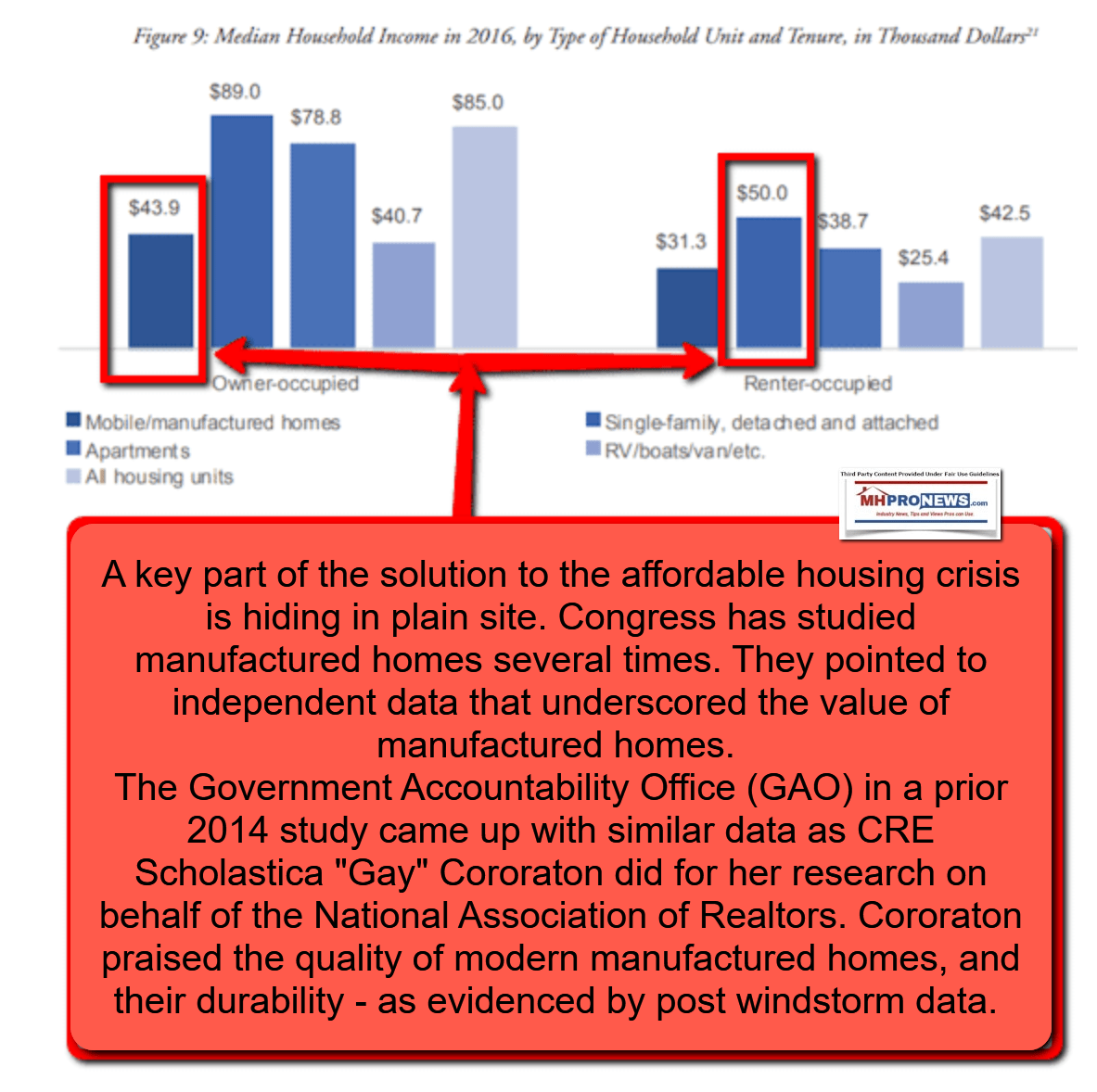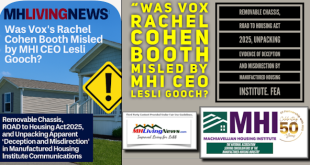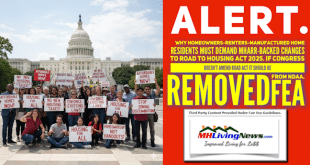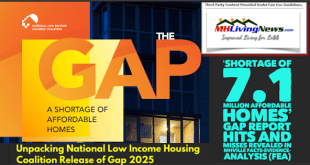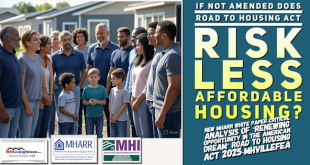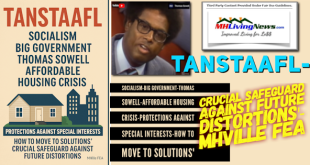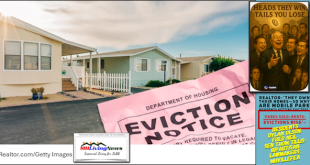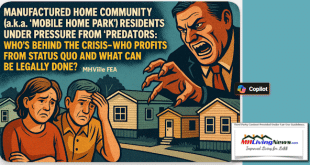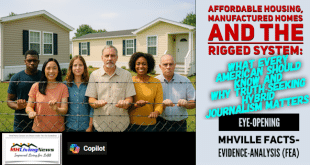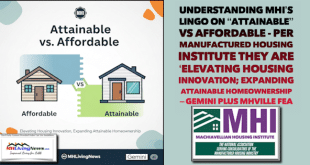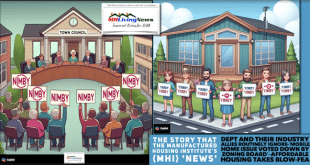The AARP Public Policy Institute published a report that merits a closer look, given the fact that inflation is roaring and there is widespread agreement that affordable housing is in great demand. Nearly half of all Americans living in manufactured homes are over 50, said AARP, which cited the sources for their data. AARP’s report below is largely favorable to manufactured housing, though a prior report they published some years before the passage of the Manufactured Housing Improvement Act (MHIA) of 2000 was not quite so glowing. Because AARP is viewed by many as being left-leaning politically, this MHLivingNews report and analysis will open with some insights from ElderGuru, which has an article that says: “These are – as you can probably imagine – conservative alternatives to AARP. Because AARP has become known as the more liberal organization, conservative-leaning individuals search for something else.”
So, those seeking insights on manufactured housing and those who may be more conservative politically seniors’ organization will each find useful insights in this article.
In fairness, having editorially reviewed the AARP article, it is in several ways apolitical. They have, as readers will see, largely focused on facts. Their report might have included more illustrations, so that those not familiar with modern manufactured homes could have an idea of how similar they are to ‘conventional housing’ – while still costing about ‘half’ the price, as AARP noted.
So, while their report misses some things, which MHLivingNews’ explores in this report, analysis, and commentary herein, the AARP report is deemed overall reliable. Obviously, costs have changed on all housing since 2019. That noted, MHLivingNews provides a more up-to-date cost-comparison of manufactured homes to conventional ‘site built’ housing following the AARP analysis. Thus, the AARP insights plus the added information provided in this article on the percentage of saving possible for seniors available with modern manufactured homes are overall relevant and useful.

What the AARP report doesn’t do, which a conservative seniors’ organization – if they opt to take up this important issue – might do is this. Explore the question: given the overall good news and free market value found in manufactured home ownership, why aren’t there more manufactured homes being sold? AARP touches on that, but more and arguably better insights could have been provided.
With that backdrop, this column will look at the following 3 segments or parts:
- what ElderGuru called the 7 primary conservative alternatives to AARP.
- That will be followed by the AARP report on manufactured housing.
- The third and final segment of this report will provide an analysis and focused commentary on parts 1 and 2.
Part 1
Per Derrick at ElderGuru – “These [seven conservative] organizations are presented in no particular order.”
1) American Seniors Association (ASA)
“Founded in 2005… Politically, the ASA claims that it will never support either a US president or a Congress that aims to cut Medicare or Social Security benefits.”
2) Christ Above Politics (CAP)
CAP states that it’s the “Christian, non-political alternative to AARP.” ElderGuru said: “CAP does no lobbying.”
3) The Association of Mature American Citizens (AMAC)
“A conservative association for elders, AMAC states that its ultimate goal is to protect the American way of life. Freedom, the US Constitution, lower taxes, smaller government, election integrity, the repeal of Obamacare, the repeal of abortion, and the protection of the Second Amendment are all some of the positions that AMAC lobbies for heavily. … AMAC might be AARP’s biggest competitor. … There are a host of benefits for AMAC members as well.” It should be noted that AMAC has several interrelated organizations and has some 2.3 million members.
4) The Seniors Coalition (TSC)
“Started in 1989, the TSC states that they lobby for any issue whatsoever that involves American seniors. … If appearances mean anything, they don’t look to be as well-funded as several other groups out there, as their website looks as if it’s straight out of 2000.”
5) 60 Plus Association
“Started in 1992, the 60 Plus Association claims to be a nonpartisan, conservative non-profit organization. They are heavily involved in political advocacy, saying that they want to lower taxes, repeal the death tax, promote the free market, become energy independent, and move towards a smaller government. They also say they want to protect Social Security, ensure access to quality healthcare…If you’re looking for discounts, it does not appear that the 60 Plus Association offers any. They are strictly political.”
6) The Alliance for Retired Americans
Founded in 2001, the Alliance for Retired Americans seeks to ensure “social and economic justice and full civil rights for all citizens.” They do this by fighting against cuts to Social Security and Medicare, lobbying to increase Part B premiums, and so on.”
7) The Alternative Association for Retired People (ALTARP)
“An organization with a Christian base that is in favor of freedom and the US Constitution. There are no benefits for members, but their donations will help to spread the message of the ALTARP – that freedom deserves to be protected and is enshrined within the American way of life. … ALTARP also advertises itself as for working people 50+ years old.”
ElderGuru said that “If you feel like you’re trapped within AARP there is hope! There are other alternatives out there that are engaged in politics and offer great benefits as well.”
Part 2 – AARP’s Insights on Manufactured Home Value for Mature Americans
According to the AARP PUBLIC POLICY INSTITUTE in JUNE 2019 (again, noting that updated cost and other information will be provided in Part 3), the following report is credited to Shannon Guzman and Jennifer Skow. The full text of the core report is provided herein, but some AARP graphics and extraneous items that refer to other reports are omitted below, but can be seen in the PDF of their article linked here.
Manufactured Housing as an Affordable Option for Older Adults
For older adults in need of affordable housing options, manufactured housing, formerly referred to as mobile homes, can be a low-cost, unsubsidized, and widely available alternative to other forms of housing. In addition, manufactured home communities may offer supportive services (personal and/or household) to help people age in place. Manufactured housing communities that offer services are more likely to manage them more efficiently given a higher number of households in close proximity.1 The quality of manufactured homes has improved dramatically over the past few decades and is of comparable quality to traditional single-family homes. The smaller square footage and reduced property upkeep of manufactured houses may be more manageable for older adults aging in community.
Who Lives in Manufactured Housing?
Nearly 6.7 million households live in manufactured housing, representing 5.5 percent of all households in the United States. Among them, 3.3 million heads of households are ages 55+ and make up nearly half (48.9 percent) of all households living in manufactured housing, a slightly larger share than among households overall in the United States (45.6 percent; see table 1).
Older adults living in manufactured housing are more likely to be homeowners (85 percent) than renters. They are also more likely to have incomes below the federal poverty level and live alone compared with older adults living in other housing types.
While the homeownership rate of older adults living in manufactured housing is higher than the United States’ rate in general (77 percent), it is lower than the homeownership rate of older adults living in single-family, detached homes (91 percent).
Of older adults who rent manufactured housing, 32 percent have incomes below the poverty level— a higher share than those who rent single-family homes (22 percent) or older adult renters in general (29 percent). Greater disparities exist, however, among older adult homeowners. Of older adult homeowners, 20 percent have incomes below the poverty level, compared with only 2 percent of those who own single-family homes and 11 percent of older adult homeowners in general.
Costs of Living in Manufactured Housing
New manufactured homes are, on average, more than 50 percent cheaper to build than new, traditional single-family homes, excluding the value of the land (table 2). The average cost per square foot is $50.42 for a new manufactured home versus $111.05 for a new site-built home.
TABLE 1Household Comparison among Older Adults in Manufactured Homes; Single-Family, Detached Homes; and US Housing Stock
|
Decline in New Shipments
The number of manufactured homes shipped each year has decreased from an average of 242,000 per year between 1977 and 1993 to just 92,500 units in 2017.2 Because manufactured homes are often titled as personal property (76 percent of houses shipped in 2017 were designated as such), it is difficult for potential buyers to obtain financing, which is often in the form of higher-interest, shorter-term, and personal property loans. Financing may be less of an issue for older adults if they purchase a manufactured home later in life with cash from the sale of a previous home.3
The HUD Code
Manufactured homes differ from all other homes in that they are built according to the Federal Manufactured Home Construction and Safety Standards, which are administered by the US Department of Housing and Urban Development (HUD). Implemented in 1976, and commonly referred to as the “HUD code,” the regulations set standards for size, exits, energy efficiency, fire safety and life safety (emergency/ evacuation systems), material and construction quality, durability, and transportability. These standards preempt local and state building codes, enabling lower costs through mass production. Manufactured housing built since 1976 is safer, more energy efficient, and longer lasting than the pre–HUD code product.4
After Hurricane Andrew destroyed many Florida communities, the HUD code was updated in 1994 and again in 1999 to make manufactured home foundations safer and the units better able to withstand high-speed winds.5 Since then, the HUD code has been updated more regularly, mandated by The Manufactured Home Improvement Act of 2000, to more accurately resemble commonly accepted residential building standards.6
Even with more stringent requirements, however, approximately 9 percent (592,000) of families in manufactured homes still live in inadequate conditions, including 2 percent (191,000) that live in severely inadequate conditions.7 Among occupied manufactured homes, the median year built is 1989,8 indicating that a significant portion of those living in manufactured homes are housed in older stock. Residents who live in older manufactured homes, and in particular, pre-1976 product, are at particular risk of living in substandard conditions.
TABLE 2
| Average Cost per Square Foot of Manufactured and Site-Built Homes |
Source: 2017 Manufactured Housing Survey, US Census Bureau. |
Obstacles to Manufactured Housing
Local communities often restrict the placement of manufactured homes through local zoning codes that dictate the size, design, and location of units. Manufactured homes can be banned from single family neighborhoods or they can be limited by stringent regulations, such as requiring larger lot sizes for manufactured homes than for site-built homes, restricting the number of units that can be placed on a lot and requiring additional onsite installation and landscaping standards.9 These zoning restrictions impede the production of new manufactured homes in urban and suburban areas and may explain why manufactured housing units are disproportionately located in rural and unincorporated areas. Nearly half (49 percent) of manufactured housing units are located outside a metropolitan statistical area compared with 22 percent of all single-family, detached housing units.10 Limitations on the production of manufactured housing reduce low-cost housing choices for low- and moderate-income households.
Manufactured Housing Communities
The Manufactured Housing Institute estimates that there are 40,000 manufactured home communities in the United States. Similar to a condominium structure, residents own their unit but pay monthly fees toward rent for the land on which the home sits, as well as general maintenance and management of the common facilities.11 Unlike a condominium, however, the manufactured homeowner has a tenant–landlord relationship with the park owner and is not represented on a management board. Leasing a lot in a manufactured home community can expand homeownership to low- and moderate-income residents because the land is not included in the cost of the home.
Another potential advantage to manufactured housing communities is that homes may be clustered together. Older residents might live closer to one another, making social interaction more likely. In addition, supportive services (e.g., meals on wheels or at-home care) can be delivered more efficiently if needed across multiple homes.
The Land Ownership Challenge
Without control over the land, residents have fewer legal protections than other homeowners. Those unwilling or unable to risk moving their home either sell, sometimes at a fraction of the original value, or abandon the home altogether. This prevents the home from becoming a true asset-building vehicle for its owners.12 Despite the common perception that manufactured homes are mobile, once the home
has been installed on its first site, it is expensive to move. It can cost $20,000 to $30,000, according to the National Manufacturer’s Homeowner’s Association, and can cause significant structural damage that may reduce the home’s value. That reality can discourage residents from moving and make them vulnerable to frequent and excessive land rent increases, poor maintenance and management of the grounds, or the conversion of the park to a different use altogether.13 There are ways residents can gain control over their communities. Some park tenants have collectively purchased their community as a cooperative, giving them control over the sale, management, and maintenance of the property while still maintaining individual ownership over their home. Collective ownership of the land eliminates the risk of community closure, stabilizes monthly lot fees, and promotes a sense of control over one’s community. Recognizing that resident ownership of land is a proven strategy in manufactured home communities, 19 states have “opportunity to purchase” policies that require or encourage park owners to give notice to homeowners so they can organize and secure financing before the land is sold on the open market.14 Ownership of the community through a nonprofit or a community land trust is another strategy to prevent closure and unfair park practices as well as retain affordability. In this scenario, a third party owns the land and rents to homeowners under longer-term leases with a commitment to the long term preservation of affordability.
Case Study: Green Pastures Senior CooperativeGreen Pastures Senior Cooperative is a resident owned manufactured housing community in Redmond, Oregon, managed by a membership elected board of directors and restricted to independent adults ages 55+. The cooperative collectively purchased a 51-lot, 9-acre park for $1.4 million in 2009 after the owner of the community decided to sell. After the closing, the cooperative spent $50,000 to repave roads and enclose trash receptacles, and take care of other deferred maintenance. Members own their homes, but each homeowner is charged about $350 per month to cover the community’s operating expenses.a Financing came from a low-interest loan of $1.05 million from Network for Oregon Affordable Housing, a second-position loan of $463,000 from Community and Shelter Assistance Corporation (CASA) of Oregon, and a $100,000 grant from Oregon Housing Community Services. In exchange for this type of financing, the community agreed to set aside half of the lots for low- and moderate-income households,b although more than 80 percent of its households earn less than 60 percent of the county’s area median income and are considered low income.c Founded in 1988, CASA of Oregon has been involved in preserving manufactured housing since 2006; it is one of nine certified technical assistance providers for Resident-Owned Communities (ROC) USA.d Green Pastures is one of many examples of resident-led ownership of manufactured housing communities. ROC USA is a nonprofit that was formed in 2008 and has overseen the transformation of more than 200 manufactured housing parks to resident-owned communities in 15 states across rural, suburban, and metropolitan settings. ROC USA’s efforts thus far have proved successful, as none of the resident-owned communities has failed, faced foreclosure, filed for bankruptcy, or sold its community.e a Green Pastures Senior Cooperative Board. Email/Phone Correspondence in December 2018. b Network for Oregon Affordable Housing, Properties Financed Index: Green Pastures Senior Park, accessed October 2018, https://noah-housing.org/docs/project_profiles/green_pastures.pdf. c Dan Elliot, “Manufactured Housing: Challenges and Opportunities,” A Presentation to Oregon Housing Stability Council, Salem, OR, 2016. d ROC-USA, Network Affiliates, accessed April 2019, https://rocusa.org/about-roc-usa/network-affiliates/. e Chelsea Catto, “Manufactured Housing Cooperatives: Innovations in Wealth-Building and Permanent Affordability,” Journal of Affordable Housing and Community Development Law 26, no. 1 (2017), pp 13–21. |
- Andree Tremoulee, “Manufactured Home Parks: NORCs Awaiting Discovery,” Portland State University: Urban Studies and Planning Faculty Publications and Presentations, Portland, OR, 2010.
- Laurie Goodman et al., Manufactured Homes Could Ease the Affordable Housing Crisis. So Why Are So Few Being Made? (Washington, DC: Urban Institute, 2018).
- Wilden and Associates LLC, “Manufactured Housing and Its Impact on Seniors,” Prepared for the Commission on Affordable Housing and Health Facility Needs for Seniors in the 21st Century, Washington, DC, 2002.
- Department of Housing and Urban Development, Manufactured Housing: Reflections from HUD Leadership (Washington, DC: Office of Policy Development and Research, HUD, 2016).
- After 2004 Hurricane Charley (Category 4), a field study conducted by the Institute for Building Technology and Safety confirmed that these updated standards improved the integrity of manufactured homes. Post-1994 products perform significantly better than pre-1994 homes and on par with site-built homes of the same age. Robert Stroh, “Hurricanes and Manufactured Housing,” The Housing News Network Journal 20, no. 3 (2004), pp 9–10.
- Matthew Furman, Eradicating Manufactured Homes: Replacement Programs as a Strategy (Cambridge, MA: Joint Center for Housing Studies, Harvard University and Neighbor Works America, 2014).
- The most common problem is related to heating; 2017 American Housing Survey.
- Ibid.
- Casey Dawkins et al., Regulatory Barriers to Manufactured Housing Placement in Urban Communities (Washington, DC: HUD PD&R, 2011).
- Goodman et al., Manufactured Homes.
- “Promoting Resident Ownership of Communities,” National Consumer Law Center, updated 2015, https://www.nclc. org/images/pdf/manufactured_housing/cfed-purchase_ pdf.
- Ibid.
- “Promoting Resident Ownership of Communities,” National Consumer Law Center.
- “Promoting Resident Ownership of Communities,” National Consumer Law Center.
Spotlight 40, June 2019
© AARP PUBLIC POLICY INSTITUTE
###
As promised above, a more recent comparison of costs of manufactured homes vs. conventional housing are found in the report below.
Part 3 – Additional Information, More MHLivingNews Analysis, Related Information, and Commentary
The AARP web page that had the above download includes these statements under “AGING DEMOGRAPHICS.” “One in Three Americans is Now 50 or Older” and “By 2030, one out of every five people in the United State will be 65-plus. Will your community be ready?””
MHLivingNews has the largest known collection of third-party researched documents, which includes those found in the report linked below.
Several of the references that AARP has in their report above, such as the Urban Institute’s 2018 report, are found on or have been previously covered by MHLivingNews. The above linked collection of third-party research includes the National Association of Realtors (NAR) Scholastica “Gay” Cororaton’s report is also a largely positive report on manufactured homes. That linked collection of independently researched information also includes Lisa Tyler’s university-level and peer-reviewed study on community attitudes about manufactured housing.


AARP cited the Manufactured Housing Institute (MHI) for their source on the estimated numbers of manufactured home communities. Unfortunately, there is evidence that suggests that the community count is one of several ‘politicized’ – and arguably errantly presented – topics at MHI. One of their own prominent members, Sun Communities CEO Gary Shiffman said there is no known accurate database for such information. Perhaps a more accurate estimate for the number of land-lease communities in the U.S. is about 45,000, not 40,000 as MHI said (and which MHI has themselves quietly has since adjusted upward).
AARP aptly noted that the MHIA of 2000 preempts local zoning.
But they don’t adequately explore why their own document accurately stated that many urban and suburban communities make placement of manufactured homes in their jurisdictions difficult. Those two facts are an apparent contradiction. While deed restricted subdivisions could and should be explored separately, for ordinary urban and suburban ‘city lots,’ manufactured homes built since the MHIA ought to be eligible for placement despite local zoning. The quotations below illustrate that point. The first statement is from the Mark Weiss, J.D., President and CEO of the Manufactured Housing Association for Regulatory Reform (MHARR). The second is a pull-quote from a longer letter by House Democrats to then-HUD Secretary Mel Martinez, which is explored in greater depth in a report linked here and another found here.
Overall, AARP did a good job of using the correct terminology and providing factually objective information.
That said, updated information on costs, and insights on important topics like LendingTree’s research that indicated that manufactured homes are appreciating in several states at a faster pace than conventional housing, are found in the reports linked above and below.
Furthermore, among the other concerns that some consumers have about manufactured home living is safety in windstorms. Briefly, properly installed manufactured housing performs about as well as conventional housing, as NAR’s Cororaton noted above. For video, facts, expert commentary and analysis that make that point, see the report linked below.
There are a range of controversies that aren’t closely examined in the AARP report. Those are routinely explored by MHLivingNews in reports found on this website, and/or on our MHProNews.com sister-site.
That noted, overall the AARP report has done a good job of presenting facts that are of interest to mature Americans – or all others – who may be considering a money-saving option in housing. It would be nice if they would update their report.
The case could be made that their smaller conservative rivals should do a similar research study on the need for manufactured homes which should explore the related controversies. In this era of runaway inflation and the need for more affordable housing, it is an issue for Americans of all ages. These topics are worthy of the attention of every senior organization. They could and should address the related issues, such as those addressed in the links herein and further below.
The bottom line is this. AARP made it clear that manufactured homes are a good option. So too have decades of findings produced by other researchers. While there is prudence in shopping carefully to avoid doing business with a predatory or problematic brand, the fact that most manufactured homeowners are happy with their affordable housing choice speaks volumes. Shopping wisely routinely leads to better outcomes and people happy with their homes that they saved money on vs. the cost of conventional housing. ##





That’s a wrap on this installment of “News through the lens of manufactured homes and factory-built housing” © where “We Provide, You Decide.” © ## (Affordable housing, manufactured homes, reports, fact-checks, analysis, and commentary. Third-party images or content are provided under fair use guidelines for media.) (See Related Reports, further below. Text/image boxes often are hot-linked to other reports that can be access by clicking on them.)

By L.A. “Tony” Kovach – for MHLivingNews.com.
Tony earned a journalism scholarship and earned numerous awards in history and in manufactured housing. For example, he earned the prestigious Lottinville Award in history from the University of Oklahoma, where he studied history and business management. He’s a managing member and co-founder of LifeStyle Factory Homes, LLC, the parent company to MHProNews, and MHLivingNews.com. This article reflects the LLC’s and/or the writer’s position, and may or may not reflect the views of sponsors or supporters.
Connect on LinkedIn: http://www.linkedin.com/in/latonykovach
Recent and Related Reports:
The text/image boxes below are linked to other reports, which can be accessed by clicking on them.
 manufacturedhomelivingnews.com Manufactured Home Living News
manufacturedhomelivingnews.com Manufactured Home Living News


